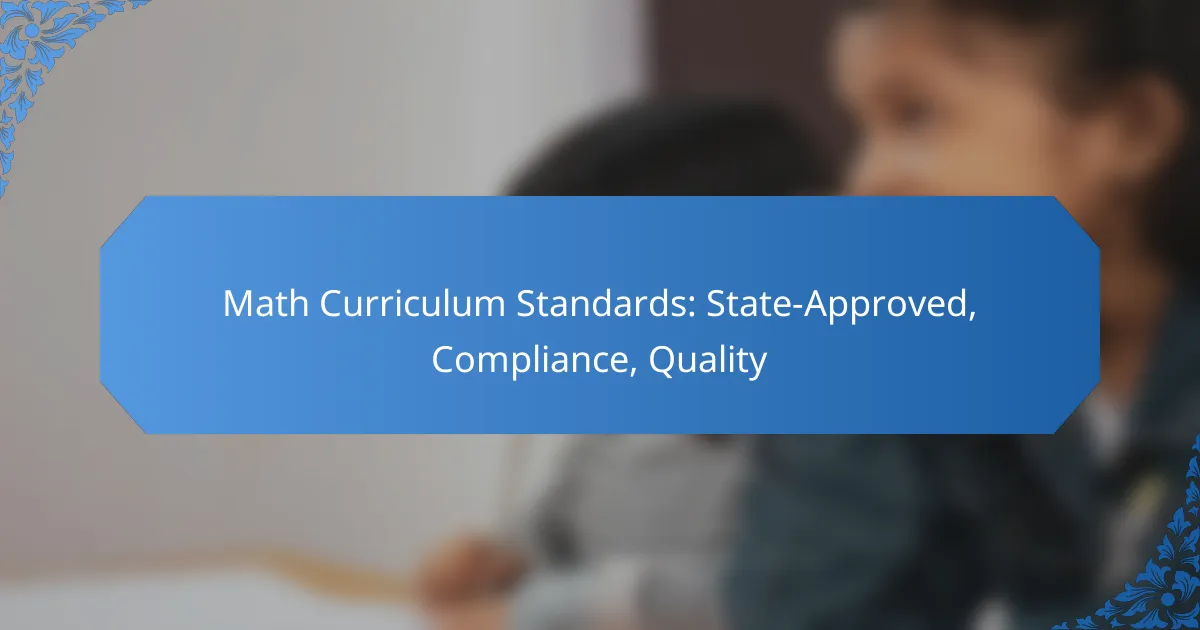Math curriculum platforms designed for online learning offer a blend of interactivity and flexibility, making them ideal for students of all ages. With features that engage learners actively and accommodate diverse learning styles, these platforms ensure that students can access personalized educational experiences anytime and anywhere.

What Are the Best Math Curriculum Platforms for Online Learning?
The best math curriculum platforms for online learning offer interactive content, flexibility, and personalized learning experiences. These platforms cater to diverse learning styles and can be accessed from various devices, making them suitable for students of all ages.
Khan Academy
Khan Academy provides a comprehensive library of instructional videos, practice exercises, and a personalized learning dashboard. It covers a wide range of math topics from basic arithmetic to advanced calculus, allowing students to learn at their own pace.
One key feature is its mastery system, which ensures that learners fully understand a topic before moving on. This platform is free to use, making it accessible to anyone with an internet connection.
IXL Learning
IXL Learning offers a personalized learning experience with adaptive questions that adjust to the student’s skill level. It covers math topics aligned with various educational standards, including Common Core and state-specific guidelines.
While IXL requires a subscription, it provides detailed analytics to track progress and identify areas needing improvement. This can help educators tailor their instruction to meet individual student needs.
Mathletics
Mathletics combines interactive activities with real-time feedback, making math engaging for students. It offers a variety of resources, including games, challenges, and assessments that align with curriculum standards.
Mathletics is subscription-based and provides teachers with tools to monitor student progress and performance. This platform is particularly effective for classrooms looking to integrate technology into their math instruction.
Prodigy Math
Prodigy Math is a game-based learning platform that makes math fun and engaging. Students solve math problems to progress through a fantasy world, which can motivate them to practice more frequently.
The platform is free to use, but additional features are available through a premium subscription. Prodigy aligns with curriculum standards, making it suitable for both home and classroom use.
DreamBox Learning
DreamBox Learning offers an adaptive math program that adjusts in real-time to each student’s learning path. It focuses on conceptual understanding and problem-solving skills, catering to students from kindergarten through eighth grade.
DreamBox is subscription-based and provides detailed reports for teachers and parents to track student progress. Its interactive lessons promote engagement and help solidify math skills in a fun way.

How Do Math Curriculum Platforms Enhance Interactivity?
Math curriculum platforms enhance interactivity by incorporating features that engage students actively in their learning process. These platforms utilize technology to provide immediate responses, foster collaboration, and create immersive experiences that make learning math more enjoyable and effective.
Real-time feedback
Real-time feedback is a critical feature of math curriculum platforms, allowing students to receive immediate responses to their answers. This instant evaluation helps learners identify their mistakes and understand concepts more thoroughly, promoting a growth mindset.
For example, platforms may highlight incorrect answers and provide hints or explanations, enabling students to correct their understanding on the spot. This immediate interaction can significantly improve retention and comprehension of mathematical concepts.
Gamified learning experiences
Gamified learning experiences transform traditional math lessons into engaging activities by incorporating game-like elements. Features such as points, levels, and rewards motivate students to participate actively and persist through challenging problems.
Many platforms offer quizzes and challenges that adapt to a student’s skill level, ensuring that they remain challenged without becoming frustrated. This approach not only makes learning fun but also encourages consistent practice, which is vital for mastering math skills.
Collaborative tools
Collaborative tools within math curriculum platforms facilitate teamwork and peer learning, allowing students to work together on problems and projects. Features like discussion boards, shared workspaces, and group challenges enable learners to exchange ideas and strategies.
These collaborative elements can enhance understanding as students explain concepts to one another, reinforcing their own knowledge while helping peers. Additionally, teachers can monitor group interactions to provide targeted support where needed, fostering a more inclusive learning environment.

What Flexibility Options Do Math Curriculum Platforms Offer?
Math curriculum platforms provide various flexibility options that cater to diverse learning styles and schedules. These options include self-paced learning, mobile accessibility, and customizable lesson plans, allowing students to engage with the material in a way that suits their individual needs.
Self-paced learning
Self-paced learning enables students to progress through math curriculum at their own speed, accommodating different learning rates. This approach allows learners to spend more time on challenging topics while moving quickly through areas they grasp easily. Many platforms offer features like progress tracking and adaptive assessments to help students stay motivated and focused.
When selecting a self-paced program, consider the balance between structure and flexibility. Some platforms provide suggested timelines, while others offer complete freedom. Look for options that include checkpoints or milestones to help maintain accountability without feeling rushed.
Mobile accessibility
Mobile accessibility allows students to engage with math content anytime and anywhere, using smartphones or tablets. This flexibility is particularly beneficial for learners who may not have consistent access to a computer or prefer studying on the go. Many platforms have dedicated apps or mobile-friendly websites that ensure a seamless experience across devices.
To maximize mobile learning, choose platforms that optimize their content for smaller screens and include interactive elements, such as quizzes and videos. Be mindful of data usage if students are accessing materials over cellular networks, and consider offline options for areas with limited connectivity.
Customizable lesson plans
Customizable lesson plans enable educators and students to tailor their math curriculum to meet specific learning goals and preferences. This flexibility can include adjusting the difficulty level, selecting particular topics, or incorporating supplementary resources. Such customization fosters a more personalized learning experience and can enhance student engagement.
When utilizing customizable lesson plans, ensure that the platform allows for easy modifications and provides a variety of resources. Look for options that support different teaching methods, such as project-based learning or collaborative activities, to cater to diverse classroom dynamics and student needs.

What Criteria Should You Consider When Choosing a Math Curriculum Platform?
When selecting a math curriculum platform, consider content alignment with educational standards, user engagement features, and pricing models. These factors will help ensure the platform meets educational goals while being interactive and cost-effective.
Content alignment with standards
Ensure the math curriculum platform aligns with local and national educational standards, such as the Common Core in the United States or the National Curriculum in the UK. This alignment guarantees that the material is relevant and meets the required learning outcomes.
Review the platform’s curriculum maps and scope and sequence documents to confirm coverage of essential topics and skills. A well-aligned platform will facilitate smoother transitions between grade levels and subjects.
User engagement features
User engagement is crucial for effective learning. Look for platforms that incorporate interactive elements like quizzes, games, and real-time feedback to keep students motivated. Features such as discussion forums or peer collaboration tools can also enhance the learning experience.
Additionally, consider platforms that offer adaptive learning technologies, which adjust the difficulty of tasks based on student performance. This personalization can significantly improve student engagement and outcomes.
Pricing models
Pricing models for math curriculum platforms can vary widely, from subscription-based services to one-time purchases. Evaluate your budget and determine whether a monthly or annual subscription fits better with your financial planning.
Some platforms may offer tiered pricing based on the number of users or features included. Be sure to compare these options to find the best value for your needs, and look for free trials to assess the platform before committing financially.

How Do Math Curriculum Platforms Support Different Learning Styles?
Math curriculum platforms cater to various learning styles by offering diverse instructional methods and interactive features. These platforms enable students to engage with content that aligns with their preferred ways of learning, enhancing understanding and retention.
Visual learning aids
Visual learning aids are essential tools in math curriculum platforms, helping students grasp complex concepts through diagrams, charts, and videos. These aids can simplify abstract ideas by providing concrete representations, making them more accessible to visual learners.
For instance, a platform might use interactive graphs to illustrate functions or geometric shapes to demonstrate the properties of angles. Such visuals can significantly enhance comprehension, especially for students who struggle with traditional text-based explanations.
When selecting a math platform, look for those that incorporate a variety of visual aids. Ensure that these resources are not just supplementary but integral to the learning experience, allowing students to visualize problems and solutions effectively.



